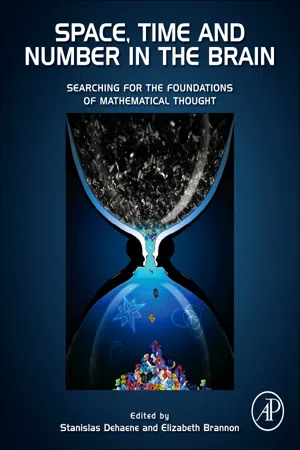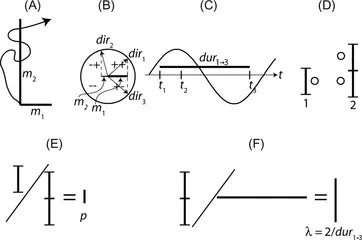
Space, Time and Number in the Brain
Searching for the Foundations of Mathematical Thought
- 374 pages
- English
- ePUB (mobile friendly)
- Available on iOS & Android
Space, Time and Number in the Brain
Searching for the Foundations of Mathematical Thought
About this book
The study of mathematical cognition and the ways in which the ideas of space, time and number are encoded in brain circuitry has become a fundamental issue for neuroscience. How such encoding differs across cultures and educational level is of further interest in education and neuropsychology. This rapidly expanding field of research is overdue for an interdisciplinary volume such as this, which deals with the neurological and psychological foundations of human numeric capacity. A uniquely integrative work, this volume provides a much needed compilation of primary source material to researchers from basic neuroscience, psychology, developmental science, neuroimaging, neuropsychology and theoretical biology.- The first comprehensive and authoritative volume dealing with neurological and psychological foundations of mathematical cognition- Uniquely integrative volume at the frontier of a rapidly expanding interdisciplinary field- Features outstanding and truly international scholarship, with chapters written by leading experts in a variety of fields
Frequently asked questions
- Essential is ideal for learners and professionals who enjoy exploring a wide range of subjects. Access the Essential Library with 800,000+ trusted titles and best-sellers across business, personal growth, and the humanities. Includes unlimited reading time and Standard Read Aloud voice.
- Complete: Perfect for advanced learners and researchers needing full, unrestricted access. Unlock 1.4M+ books across hundreds of subjects, including academic and specialized titles. The Complete Plan also includes advanced features like Premium Read Aloud and Research Assistant.
Please note we cannot support devices running on iOS 13 and Android 7 or earlier. Learn more about using the app.
Information
C.R. Gallistel
Why Arithmetic is Special
 |
| Box 1.1 Figure 1 (A) The representation or location in two or three dimensions, as in dead reckoning while foraging (trace ending in location arrow), may be mediated by a vector composed of two or three magnitudes (m1 & m2). (B) The representation of direction, which is critical in dead reckoning, may be reduced to a magnitude proportional to the cosine of the direction angle and two signs. The signs code the quadrant. The magnitude codes direction within it: dir1 is encoded by 〈m1,+,+〉, dir2 by 〈m2,−,+〉 and dir3 by 〈m1,+,−〉. (C) Durations are represented by single magnitudes (dur1→3), which may be computed from differences in temporal locations (t1,t2,t3): dur1→3=t3−t1. Temporal locations may be represented by the phases of endogenous clocks, like the circadian clock [22] and phase may be represented in the same way as directions: 〈m1,+,+〉, 〈m2,−,+〉 and 〈m1,+,−〉 could represent t1,t2,t3 as readily as dir1, dir2, and dir3. (D) Numerosity is also represented by analog-like magnitudes [23]. (E) Dividing magnitudes representing numerosity (discrete quantity) generates magnitudes representing probability and proportion (continuous quantities). (F) Dividing magnitudes representing numerosity by magnitudes representing duration yields magnitudes representing rates. |
Computational Implications of Behavioral Results
Table of contents
- Cover image
- Table of Contents
- Front-matter
- Copyright
- Contributors
- Foreword
- Section I Mental Magnitudes and their Transformations
- Chapter 1. Mental Magnitudes
- Chapter 2. Objects, Sets, and Ensembles
- Chapter 3. Attention Mechanisms for Counting in Stabilized and in Dynamic Displays
- Section II Neural Codes for Space, Time and Number
- Chapter 4. A Manifold of Spatial Maps in the Brain*
- Chapter 5. Temporal Neuronal Oscillations can Produce Spatial Phase Codes
- Chapter 6. Population Clocks
- Chapter 7. Discrete Neuroanatomical Substrates for Generating and Updating Temporal Expectations
- Chapter 8. The Neural Code for Number
- Section III Shared Mechanisms for Space, Time and Number?
- Chapter 9. Synesthesia
- Chapter 10. How is Number Associated with Space? The Role of Working Memory
- Chapter 11. Neglect “Around the Clock”
- Chapter 12. Saccades Compress Space, Time, and Number*
- Section IV Origins of Proto-Mathematical Intuitions
- Chapter 13. Origins of Spatial, Temporal, and Numerical Cognition
- Chapter 14. Evolutionary Foundations of the Approximate Number System
- Chapter 15. Origins and Development of Generalized Magnitude Representation
- Section V Representational Change and Education
- Chapter 16. Foundational Numerical Capacities and the Origins of Dyscalculia*
- Chapter 17. Neurocognitive Start-Up Tools for Symbolic Number Representations*
- Chapter 18. Natural Number and Natural Geometry
- Chapter 19. Geometry as a Universal Mental Construction
- Chapter 20. How Languages Construct Time
- Chapter 21. Improving Low-Income Children’s Number Sense
- Index